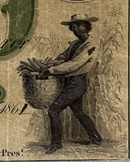by Nick Gromicko
1/2/2023
I'm both a farmer and collector/broker of old paper currencies and banknotes. Visit my paper currency and banknote collection. I'm a fruit tree farmer but I also have a small corn field. Being a farmer, I was very pleased to discover the depiction of a farmer carrying a basket of corn on an old $50 banknote that I recently acquired. It was issued by The Bank of Howardsville in Virginia in 1861. Back then, banks issued their own money. This system worked fine as most people didn't travel outside of their local area. The town's people would use the currency issued by the bank of that town. It was also common for banknotes to depict images of people being industrious. See the bottom right corner:

Here is a closeup of the farmer. You will notice the great detail in the corn, the basket and even the farmer's shirt and pants. All this hand-created detail, engraved for the banknote, was done to make counterfeiting difficult.

As I explained though, I'm a farmer and so recall seeing this image before. So I began searching through my entire collection to see if I already owned this particular banknote. I found it alright, but not where I expected. I found it on a $3 banknote issued from a different bank. As it turns out, the image was originally engraved by The Citizens Bank of Washington, D.C. It was issued in 1853, years earlier than the 1861 note I had just purchased. I now had two totally separate banknotes from different banks containing the same image. Presumably the Bank of Howardsville in Virginia didn't want to have to re-engrave the detailed image and so borrowed it from The Citizens Bank of Washington, D.C. for use on their banknote. Here it is:

And here is a closeup of the farmer:

Notice the differences between the farmers? One is dark-skinned and one is light-skinned. The dark-skinned image has curly hair and his shirt is torn and has an elbow patch. The light-skinned one has straighter hair and a shirt without tears or patches. So what is going on here? I think I figured it out. Between the time these two banknotes were issued, 11 states seceded from the Union and formed The Confederate States of America. Virginia was one of the states that seceded. Apparently the Bank of Howardsville in Virginia didn't want to display a white man working in a field and so they altered the image they got from The Citizens Bank to make him look more like a slave.
I love collecting old paper currencies and banknotes because they were used to make political and social statements of their time. This is the only example, that I know of, where an engraving on one currency' was specifically altered to suit a geographical region's position on another currency. In this case, that position was regarding the use of enslaved labor.
This rare pair of notes is available for purchase for $4000.00.
###
Visit Nick's Paper Currency and Banknote collection.
Read Nick's article on Storing Wealth.
What do these five U.S. paper currencies all have in common?



